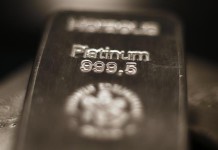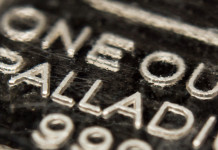
[miningmx.com] – DEMAND for South Africa’s platinum-backed exchange traded fund (ETF) – the largest in the world with 780,000 ounces sold to date – was likely to be ‘sticky’, said Johnson Matthey, the UK research house and autocatalyst manufacturer.
“The general view is that it will be more sticky,” said Peter Duncan, GM of market research at Johnson Matthey. “It’s seen as a hedge against South African mine production and there’s no sign of disinvestment,” he said.
It had been suggested by Stuart Murray, chairperson of Sylvania Resources, at an mining investment conference in October, that the popularity of the fund, brought to the market by Absa Capital, had introduced so-called “hot money’ into the platinum market.
He suggested that the liquidation in gold-backed ETFs, especially from January to April, helped make gold vulnerable and resulted in its subsequent price weakness, and that the same could happen to the platinum price.
Investment in gold-backed ETFs fell to about $80bn as of November 5 compared to $144bn at the end of 2012, according to a report by Macquarie Research. Silver ETFs had fallen to $14bn from $19bn over the same period. Investment in platinum ETFs, however, had risen from $2.6bn to $3.6bn this year, it said.
“It’s always a double-edged sword: EFTs help support the price over the years and can then destroy the price,” said Duncan. “But there’s been average net growth of 75,000 oz [in the Johannesburg fund]. I think it will be sticky,” he said.
In its report, Macquarie Research said it thought the success of the Johannesburg ETF represented fresh investment demand.
“Although one has to assume this fund, launched only at the end of April, has taken market share from other platinum ETFs, they are down only 43,894 oz during its lifetime, meaning the majority of its offtake is fresh demand, at least for ETFs (other forms of platinum investment might have been liquidated),” it said.
So popular has the Absa’s ETF been – known as the NewGold Platinum Debenture – that it was the main driver of a 68% year-on-year improvement in investment demand for platinum. In fact, without the EFT, net platinum investment inflows during 2013 would have been 5,000 oz, said Jeremy Coombes, GM for marketing and publications at Johnson Matthey. Coombes was presenting the company’s 2013 interim review in Johannesburg for the last time after an announcement earlier this year that Anglo American Platinum (Amplats) had ended a 21-year purchase agreement with Johnson Matthey.
Coombes said Johnson Matthey would continue to conduct research on the platinum group metal markets for clients, but it would discontinue the annual interim review which was part of the purchasing agreement with Amplats.
Coombes said one aspect to watch was the possibility that a palladium-backed ETF planned by Absa Capital deflected some funds from platinum.
“There may be some transfer. There is a limit on funds that can go into commodities and we don’t know how close the institutions are to the limit. So maybe that’s an area to watch,” he said.
Absa Capital said in September that had won regulatory approval for the launch of a palladium-backed EFT for the Johannesburg market.
Vladimir Nedelkjovic, head of ETFs and Index Products at Absa Capital, said he didn’t didn’t think the prospect of cannibalisation was a major issue, however. “We are responding to investor demand. If there is cannibalisation, then so be it,” he said.
“Globally, palladium ETFs are as big as platinum products but I’m not so sure that will be the case in South Africa. About 80% of platinum is produced in South African and it’s seen as a South African metal whereas only 30% of palladium is produced here,” he said.
The aim was to launch the palladium ETF before the end of November. “We know that South Africa goes on leave after that; so if it’s not in November, we will work on a launch in early January,” Nedelkjovic said.











